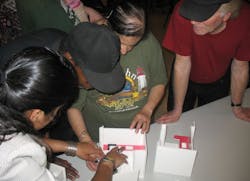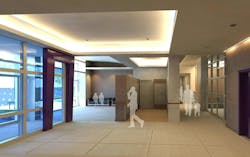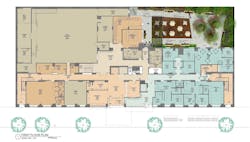New York's first-ever public housing for visually-impaired begins upgrade
Magnusson Architecture and Planning (MAP) and Associated Blind Housing Development Fund Corporation (Associated Blind HDFC) broke ground on a $38 million building upgrade at Selis Manor. Selis Manor is the first government-funded residence for the vision-impaired and disabled in New York City. Associated Blind HDFC manages the residence, which opened in 1980. The repairs and capital improvements are its first-ever building upgrades. The phased construction is set to be complete by 2016.
The 14-story building is located at 135 West 23rd Street in Manhattan. It has 205 studio, one-, and two-bedroom units. Amenities include a roof terrace, courtyard, bowling alley, fitness center, computer center, library, and auditorium.
The speakers at the ceremony were Brian Daniels, associate commissioner of the New York State Office of Children and Family Services: Commission for the Blind; Leroy Latiker III, underwriter-project manager of production and development at U.S. Department of Housing and Urban Development; Tony Saverese, Developer/Managing Agent at Associated Blind HDFC; Joyce Carrico, tenant association representative and resident at Selis Manor; E. Perry Winston, associate at Magnusson Architecture and Planning; and Joe Malewich, board member of Associated Blind HDFC.
All of the public spaces will be upgraded and a new entrance will be added. Each of the apartments will have new fixtures and finishes. The separate kitchens will be connected directly to the living areas of the residential units for better flow and circulation. The renovation includes a full MEP systems upgrade that will lower energy usage.
“This long-awaited renovation will improve the safety and quality of housing for Selis Manor’s residents,” said Tony Savarese, Developer/Managing Agent at Associated Blind HDFC. “It is always a challenge to renovate an occupied building, and it is even more complicated when the occupants are visually-impaired. We worked closely with MAP on a plan that will ensure the safety of all residents during construction.”
Residents are supported by U.S. Department of Housing and Urban Development (HUD)’s Housing Choice Voucher Program, also known as Section 8. Associated Blind HDFC will arrange for temporary living spaces for every tenant on a rotating basis. The phased construction will take place two floors at a time.
Touchable models
Many of the residents have lived in the building since it opened. During the design phase of the project, MAP created touchable models of the new apartment layouts. The models acted as three-dimensional aides that helped the visually-impaired residents understand the changes by touch. Using the models as a guide, MAP’s architects engaged the residents in the process. They also incorporated the residents’ suggestions into the renovations.
“MAP has designed all types of housing, ranging from market-rate to affordable, and everything in between,” said Magnus Magnusson, AIA, LEED AP, founding principal of MAP. “So we know how to address the unique needs of particular residents. Selis Manor is over 30 years old, and long overdue for an upgrade. When the renovation is complete, all residents will have high-quality amenities and a superior standard of living – the kind of housing that all New Yorkers need and deserve.”
Fewer hurdles
MAP’s design eases crowding, increases security, and separates residents and visitors. Currently, the one entrance is shared by 250 residents and the patrons of VISIONS, a not-for-profit that provides services, including meals and classes, for over 500 people each day. This traffic causes congestion in the common areas of the ground floor. A new residents-only entrance will be protected with an electronic pass system. The other entrance will be for VISIONS patrons.
Scored terrazzo flooring will help residents navigate within the building. A path along the floor will guide residents toward elevators and indicate stair landings. A new guardrail along the south façade of the building facing 23rd Street will include Braille inserts describing the history of the residence that lead toward the entrance. MAP consulted with Chris Downey, a San Francisco-based architect who became blind at the age of 45.
The architects expect NYSERDA Multi-family Participation Program (MPP) certification for the project. EME Group provided MEP engineering and Nash Associates provided structural engineering. Rockport Mortgage Corp. and Forsyth Street Advisors helped secure financing for the project.
Sign up for Building Design+Construction Newsletters
Get the latest news and updates.



